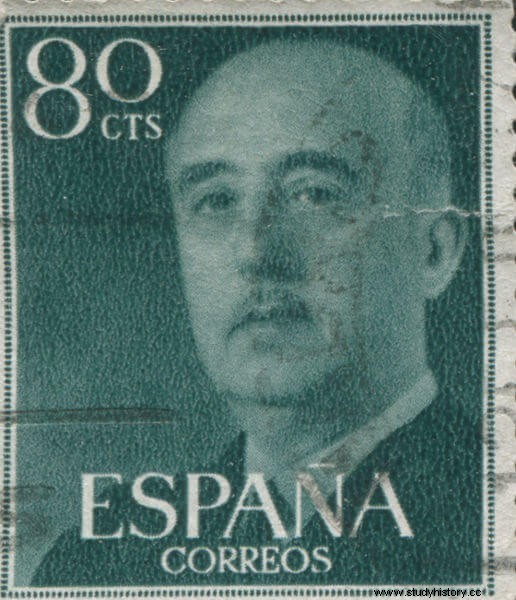
Who was General Franco?
Francisco Franco was a Spanish general who became very famous for having been the dictator of Spain between 1936 and 1975. The dictatorship imposed by Francisco Franco was called Francoism and only ended with the death of its leader.
Francisco Franco's rise to power in Spain took place through the Spanish Civil War, a conflict between 1936 and 1939 in which the military and conservative groups reacted militarily against the republic installed in Spain. The conflict began with the mobilization of republican and federalist groups, many linked to leftist organizations, in defense of the republic against the attempted coup led by Franco and the Spanish military.
To win the war, Francisco Franco and the groups that supported him, known as the National Movement, had the help of the Fascist regime in Italy and the Nazi regime in Germany, which sent troops and armaments for Spanish conservatives during the Civil War.
Once victorious, Francisco Franco put an end to the Second Spanish Republic, beginning the Kingdom of Spain. He established himself in power and ruled the country until 1975 with a conservative and nationalist dictatorship that possessed fascist characteristics.
Also see: Learn how fascists took power in Italy in the 1920s
Biography
Francisco Paulino Hermenegildo Teódulo Franco Bahamonde was born on December 4, 1892 in Ferrol, a city located in Galicia, Spain. Francisco Franco was a member of a family with a long tradition in the Spanish navy and, during his youth, he had expectations of following the same career.
Francisco Franco's wish was frustrated, as, at the time he was young, the Spanish Naval Academy was not accepting new recruits. So Franco went on to the infantry, joining the Infantry Academy in 1907. In 1912, he was sent to fight in the Melilla War, and in 1915 he already had the rank of captain.
In 1923, he became commander of the Spanish Legion, a military group similar to the French Legion. That same year, the coup that brought Primo Rivera to power in Spain took place. Rivera's government lasted from 1923 to 1931 and was a conservative dictatorship. Although Franco was not involved in the coup, he took advantage of it to develop his military career. In 1926 he was promoted to the rank of general, and in 1928 he was appointed director of a military school in Zaragoza.
In 1931, the Second Spanish Republic was proclaimed, whose new government did not please Francisco Franco, who was a defender of monarchism. Franco's friction with the Second Spanish Republic increased when the center-right coalition that ruled the country was defeated in the elections by a left-wing coalition.
Franco, who already had the practice of using conspiracy theories to accuse his political opponents, began to openly conspire to overthrow the republic in Spain. As a result, Francisco led, on July 18, 1936, a coup to overthrow President Manuel Azaña Diaz and, consequently, the republic.
Immediately after the coup, there was a reaction from republican, federalist and democratic groups in defense of the Second Spanish Republic. Along with this resistance, there were a series of socialist, anarchist, syndicalist organizations, among others. The clash of these two groups started the Spanish Civil War, a conflict that only ended in 1939.
How did Francisco Franco die?
Franco suffered from Parkinson's and had a heart attack, which forced him to undergo a series of surgical procedures, which led to a coma. While he was hospitalized, he kept himself alive with the help of devices. Francisco Franco died on November 20, 1975, after his family's decision to turn off the equipment that kept him alive.
With the death of the dictator, a process of political transition began in Spain, led by Juan Carlos de Borbón , Franco's successor. In this way, liberal democracy was restored in the country, putting an end to the Franco dictatorship.
Dictatorship
In 1936, through the coup against the Spanish Republic, Francisco Franco and the National Movement took control of part of Spain. Franco's forces were only able to impose themselves against the republic's defenders and fully control the country after years of conflict.
With the consolidation of Franco's victory, the Franco dictatorship was established throughout Spain, which lasted until 1975, when the Spanish dictator died. Historians consider that, until 1945, the year in which the Second World War ended, Franco's government had a fascist orientation.
During the Second World War, Franco chose to remain in a position of neutrality, despite having received support from fascists and Nazis in previous years. With the defeat of his support group – the Axis –, Franco promoted a “defascitization” of his government. In any case, Francoism was a dictatorial government and conservative.
Another striking feature of the Franco dictatorship was the repression of cultural minorities in Spain. As a nationalist regime, Franco persecuted ethnic minorities from Spain, like the Catalans and the Basques .
The Franco dictatorship, over the four decades, was marked by the concentration of power in the leader, extreme nationalism and persecution of groups that did not align with the government's ideals, the absence of political parties , only the government party being allowed to act, absence of democracy and anti-liberalism. Franco's dictatorship was also directly integrated with the Catholic Church.
Also see: Learn about the years of the first government of the Military Dictatorship in Brazil
*Image Credits:Dariush M and Shutterstock
